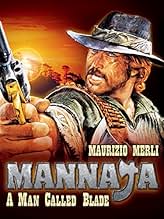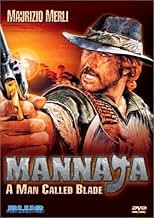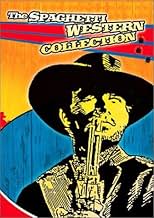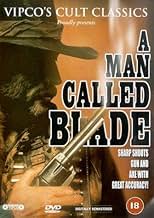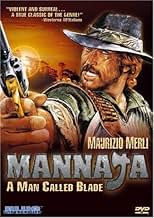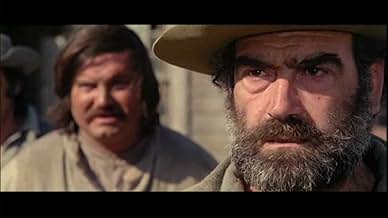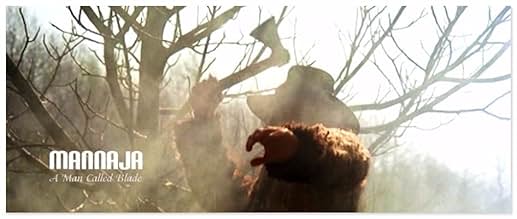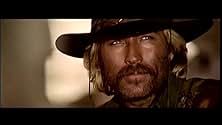NOTE IMDb
6,5/10
2,1 k
MA NOTE
Ajouter une intrigue dans votre langueA bounty hunter is hired by a mining town's crippled mayor to find his daughter, who has been kidnapped by the mayor's corrupt right-hand-man and his outlaw gang.A bounty hunter is hired by a mining town's crippled mayor to find his daughter, who has been kidnapped by the mayor's corrupt right-hand-man and his outlaw gang.A bounty hunter is hired by a mining town's crippled mayor to find his daughter, who has been kidnapped by the mayor's corrupt right-hand-man and his outlaw gang.
- Réalisation
- Scénario
- Casting principal
Antonio Casale
- Dahlman
- (as Nino Casale)
Rik Battaglia
- Gerald Merton
- (as Rick Battaglia)
Vincenzo Maggio
- Oldtimer
- (as Enzo Maggio)
Sofia Lombardo
- Lucy Merton
- (as Sophia Lombardo)
Giuseppe Cardone
- Poker player
- (non crédité)
Domenico Cianfriglia
- Valler Henchman
- (non crédité)
Arnaldo Dell'Acqua
- Valler Henchman
- (non crédité)
Ottaviano Dell'Acqua
- Rioting Miner
- (non crédité)
Avis à la une
By 1977, the spaghetti western was already on its death throes and if I'm not horribly mistaken, Mannaja is the last major release in the genre. These latter day spaghetti westerns are all visibly different from the 67-71 ones in that they tried to push the envelope in different ways. Ironically the vast amount of tired, quickie Django and Sartana clones that sprung in the late 60's weren't the final nail in the coffin. It seems that after westerns like Mannaja the genre had nowhere to go, having explored every nook and cranny of the old west and milked every bit of potential in the process.
Sergio Martino was not a regular spaghetti western director. He made his name through a series of fantastic giallo thrillers in the early 70's (All the Colours of the Dark, The Strange Vice of Mrs. Wardh etc) but he was generally a genre director who dabbled with anything that came his way. As a testament to his talent, he was usually successful, often with stunning results. He had tried his hand on the western once more in the Anthonio De Steffen vehicle Arizona Colt Returns, which was a pleasurable entry but business as usual for the most part. Mannaja is markedly different in that it strives for more. It has ambition and the means to pull it off.
Strangely, Mannaja takes its cue from Enzo G. Castellari's incredible Keoma (or as it was retitled for commercial purposes, Django Rides Again) from one year earlier. Maurizio Merli's Mannaja bears more than a passing resemblance to the dirty and grim looking Keoma played by Franco Nero, there are several beautiful slo-mo shots, a dream-like atmosphere in places, it's quite brutal (a hand is chopped, a woman is whipped, a man gets an axe in his head, old ladies and other innocent bystanders are shot and killed) and the score is very weird by spaghetti western standards and it can be as annoying as Keoma's (although I didn't mind the latter). Just as Keoma, it doesn't shy away from taking risks and luckily it pays off, no least thanks to Martino's skillful directing. There's visual awesomeness to be found throughout the movie. Striking compositions are enhanced by great set design lending a gritty feeling to everything from the dilapidated town to the dirty clothes to the muddy streets. Nature plays a big part in how the movie looks: rain, mud, fog are all used to great effect, the last shootout in the fog adding a surreal, ghost-town quality to it. The look of the first half hour reminded me of Altman's McCabe and Mrs. Miller for some reason, with a dash of Django. It also appears to be very much influenced by the work of Sam Peckinpah, whom Sergio Martino himself cites as an inspiration. Generally it's equal parts gritty and atmospheric and with enough budget to hold everything on the seams.
Maurizio Merli made his name in the Italian movie business by playing violent Dirty Harry-esquire cops in polizioto crime flicks and was quite successful as a genre actor. He can play the mean machine effortlessly and it's a real pleasure to watch him as a badass bounty hunter here. A real shame that he didn't do more westerns and even more so that he passed away 4-5 years after making this one. The rest of the cast all turn in fine performances.
Mannaja might have come during the twilight of the spaghetti western but it's easily one of the best it has to offer. A must-see for fans.
Sergio Martino was not a regular spaghetti western director. He made his name through a series of fantastic giallo thrillers in the early 70's (All the Colours of the Dark, The Strange Vice of Mrs. Wardh etc) but he was generally a genre director who dabbled with anything that came his way. As a testament to his talent, he was usually successful, often with stunning results. He had tried his hand on the western once more in the Anthonio De Steffen vehicle Arizona Colt Returns, which was a pleasurable entry but business as usual for the most part. Mannaja is markedly different in that it strives for more. It has ambition and the means to pull it off.
Strangely, Mannaja takes its cue from Enzo G. Castellari's incredible Keoma (or as it was retitled for commercial purposes, Django Rides Again) from one year earlier. Maurizio Merli's Mannaja bears more than a passing resemblance to the dirty and grim looking Keoma played by Franco Nero, there are several beautiful slo-mo shots, a dream-like atmosphere in places, it's quite brutal (a hand is chopped, a woman is whipped, a man gets an axe in his head, old ladies and other innocent bystanders are shot and killed) and the score is very weird by spaghetti western standards and it can be as annoying as Keoma's (although I didn't mind the latter). Just as Keoma, it doesn't shy away from taking risks and luckily it pays off, no least thanks to Martino's skillful directing. There's visual awesomeness to be found throughout the movie. Striking compositions are enhanced by great set design lending a gritty feeling to everything from the dilapidated town to the dirty clothes to the muddy streets. Nature plays a big part in how the movie looks: rain, mud, fog are all used to great effect, the last shootout in the fog adding a surreal, ghost-town quality to it. The look of the first half hour reminded me of Altman's McCabe and Mrs. Miller for some reason, with a dash of Django. It also appears to be very much influenced by the work of Sam Peckinpah, whom Sergio Martino himself cites as an inspiration. Generally it's equal parts gritty and atmospheric and with enough budget to hold everything on the seams.
Maurizio Merli made his name in the Italian movie business by playing violent Dirty Harry-esquire cops in polizioto crime flicks and was quite successful as a genre actor. He can play the mean machine effortlessly and it's a real pleasure to watch him as a badass bounty hunter here. A real shame that he didn't do more westerns and even more so that he passed away 4-5 years after making this one. The rest of the cast all turn in fine performances.
Mannaja might have come during the twilight of the spaghetti western but it's easily one of the best it has to offer. A must-see for fans.
Although very much late in the game for an Italian western, (the bulk of which were made between 1965 and 1972) Mannaja (A Man Called Blade) is no slouch. It's actually a good muscular western with lots of violence and dark atmosphere, with the sun blocked out and everything bathed in a fog of dust.
Maurizio Merli plays Blade, a mysterious hatchet wielding bounty hunter with unfinished business to take care of regarding a puritanical mine owner and his psychotic number two, played by John Steiner, who's excellent at portraying nasty weasels.
Also memorable is (the late?) Donal O'Brien, who would later gain infamy as the title character in Doctor Butcher M.D. (Medical Deviate), as a scroungy fugitive who gets his hand cut off by Blade in the first scene and features prominently in the film's finale.
Director Sergio Martino is a master of Italian exploitation and really knows how to deliver the goods, especially in action/adventures. Another of his films I really enjoyed was Slave Of The Cannibal God with Ursula Andress and Stacy Keach.
Also, I really enjoyed the title song even though it was repeated way too often in the course of the film.
Maurizio Merli plays Blade, a mysterious hatchet wielding bounty hunter with unfinished business to take care of regarding a puritanical mine owner and his psychotic number two, played by John Steiner, who's excellent at portraying nasty weasels.
Also memorable is (the late?) Donal O'Brien, who would later gain infamy as the title character in Doctor Butcher M.D. (Medical Deviate), as a scroungy fugitive who gets his hand cut off by Blade in the first scene and features prominently in the film's finale.
Director Sergio Martino is a master of Italian exploitation and really knows how to deliver the goods, especially in action/adventures. Another of his films I really enjoyed was Slave Of The Cannibal God with Ursula Andress and Stacy Keach.
Also, I really enjoyed the title song even though it was repeated way too often in the course of the film.
Eurocrime regular Maurizio Merli headlines this Italian Western about the title bounty hunter, who wields a hatchet rather than a gun. He comes upon the town of Suttonville, which is presided over by a mining boss, McGowan (Philippe Leroy) who supposedly doesn't allow any sort of "sin" or "vice". Mannaja gets caught up in the affairs of the town, going head to head with the crooked and deadly Voller (European exploitation veteran John Steiner) and seeing to some unfinished business that he has with McGowan.
"Mannaja" is directed by Sergio Martino, who was nothing if not versatile, moving from Gialli ("Your Vice is a Locked Room and Only I Have the Key") to post-apocalypse schlock ("2019: After the Fall of New York"), to the cannibal genre ("Mountain of the Cannibal God"). Martino gives the tale some real style, beginning and ending it with very atmospheric sequences. The violence is pretty vicious, but offsetting a certain grimness is a tendency towards levity at times. A case in point: Johnny-Johnny (Salvatore Puntillo) and his dancing girls. The music further adds to the atmosphere, having been composed by Guido and Maurizio De Angelis. Martino gets down to business with an eerie succession of scenes in which outlaw Burt Craven (Donald O'Brien) is pursued by Mannaja.
The charismatic Merli, who does indeed bear a resemblance to the more famous Franco Nero, does a capable job in the lead. He's extremely well supported by Steiner, who looks right at home in this genre; Steiner is a great villain. Leroy, O'Brien, Martine Brochard as dancing girl Angela, and Sonja Jeannine as McGowan's daughter are all fine as well.
Overall, "Mannaja" is pretty good of its type, offering up nice photography, lovely ladies, decent action sequences, a few laughs, and a plot where the hero doesn't always have the upper hand.
Seven out of 10.
"Mannaja" is directed by Sergio Martino, who was nothing if not versatile, moving from Gialli ("Your Vice is a Locked Room and Only I Have the Key") to post-apocalypse schlock ("2019: After the Fall of New York"), to the cannibal genre ("Mountain of the Cannibal God"). Martino gives the tale some real style, beginning and ending it with very atmospheric sequences. The violence is pretty vicious, but offsetting a certain grimness is a tendency towards levity at times. A case in point: Johnny-Johnny (Salvatore Puntillo) and his dancing girls. The music further adds to the atmosphere, having been composed by Guido and Maurizio De Angelis. Martino gets down to business with an eerie succession of scenes in which outlaw Burt Craven (Donald O'Brien) is pursued by Mannaja.
The charismatic Merli, who does indeed bear a resemblance to the more famous Franco Nero, does a capable job in the lead. He's extremely well supported by Steiner, who looks right at home in this genre; Steiner is a great villain. Leroy, O'Brien, Martine Brochard as dancing girl Angela, and Sonja Jeannine as McGowan's daughter are all fine as well.
Overall, "Mannaja" is pretty good of its type, offering up nice photography, lovely ladies, decent action sequences, a few laughs, and a plot where the hero doesn't always have the upper hand.
Seven out of 10.
The titular character thankfully isn't an ancestor of overrated vampire-hunter Wesley Snipes, but a genuinely old-fashioned and testosterone-laden spaghetti western hero who furiously wanders around the deserts like a one-man-army, hunting down wanted criminals for the rewards on their head. Blade is relentless but fair, he has an imposing charisma and wields hatchets as professionally as he fires shotguns. In short, he's the ideal guy to dedicate another magnificently violent, imaginative and nasty euro-Western to! And, oh yes, Sergio Martino's film can easily compete with the absolute greatest efforts in this sadly extinct sub genre of cult cinema, like Sergio Corbucci's "Django", Sergio Sollima's "The Big Gundown" and perhaps even some of Serio Leoni's lesser known movies. "A Man Called Blade" is a very eventful and exciting film, chock-full of outrageous gun & fistfights, mean & treasonous bandits and wild ambushes. When arriving in the little town of Suttonville to claim the reward on a killer's head, Blade encounters the vicious & corrupt sidekick of a prominent businessman. Blade offers his services to McGowan and Voller, because despite exploiting the local miners, large troops of outlaws continuously steal the silver. Voller wants to get rid of Blade as soon as possible, because he plots to take over the empire, but Blade is tough and has an extra personal score to settle with McGowan. The plot twists perhaps aren't the most original ones ever, but bear in mind "A Man Called Blade" got released during the dying years of spaghetti western cinema. And even though not always original, Martino's film is fast-paced and doesn't feature a single dull moment. The fights are dirty (literally) and the violence is rather graphic, with several cowboys dying from hatches in their foreheads or bullets between the eyes. The outdoor locations are sublime and I absolutely loved the moody theme song that gets repeated during the film's most essential sequences. Other fans seem to disapprove of the music in this film, but I thought it was excellent. Maurizio Merli makes a terrific macho hero. Perhaps not as legendary as Franco Nero or Tomas Milian, but close enough. The film sadly doesn't have a strong female lead, only a sympathetic go-go dancer and the silent daughter of the mayor. The most memorable performance is given by John Steiner as Blade's sadistic opponent Voller. With his ugly face and almost natural aura of arrogance, Steiner gave image of multiple villains in Italian cult films. His role here definitely ranks among the best! Highly recommended.
I found this film to be quite inspirational, actually. The movie is about a man who wields a blade for a weapon in fending off the bad guys while rescuing the girl from the evil villain, Voller (brilliantly played by John Steiner). At the beginning of the film we find our rogue hero Blade (played by Maurizio Merli) chasing after a man through the misty swamps. The man looks behind him frantically several times to try to make out the figure of his pursuer. Suddenly there is a swishing noise in the air as a hatchet blade strikes the man, severing his right hand against a tree. Thus begins the tale, and follows our hero into a virtual ghost town, where "sin and vice are not permitted." He enters a saloon where he and his new companion (the man with the severed hand) receive several shifty-eyed glances. This is when Blade first meets the dastardly Voller and wagers a gamble playing cards, to which of course our hero wins. The filming technique used throughout this scene is truly classic, where some shots show a profile of the villain on one side of the screen, with Blade standing in the background. The character acting is superb. I cannot speak enough about how Steiner personifies the classic old west villain to a "T". His snide mannerisms and long, lean stature lend to his overall character appeal. Throughout this film, there is plenty of splendid gunfighting and even a particularly notable scene in which Blade dukes it out with Voller and three of his henchmen in the mud. Yes, the actor actually does 90% of these stunts (as I later found out watching the director interview on DVD)! The director, Sergio Martino, could not have directed a more well-scripted film, complete with all the elements of a traditional spaghetti western! I give this film 3 out of 4 stars, mainly for its overall character appeal and for the simple fact that it's a 70's flick! 'Nuff said...
Le saviez-vous
- AnecdotesThe reason the exteriors have so much fog and smoke was because the filmmakers were trying to hide the fact that the studio, Elios Studio near Rome, needed to be renovated.
- GaffesIn the opening sequence the man captured screams and you can clearly see his modern fillings.
- Versions alternativesUK versions are cut by 6 secs by the BBFC to remove footage of horsefalls.
- ConnexionsFeatured in The Spaghetti West (2005)
Meilleurs choix
Connectez-vous pour évaluer et suivre la liste de favoris afin de recevoir des recommandations personnalisées
Détails
- Date de sortie
- Pays d’origine
- Langue
- Aussi connu sous le nom de
- A Man Called Blade
- Lieux de tournage
- Campo Imperatore, L'Aquila, Abruzzo, Italie(Stagecoach / Horse Riding Scenes)
- Sociétés de production
- Voir plus de crédits d'entreprise sur IMDbPro
- Durée
- 1h 41min(101 min)
- Mixage
- Rapport de forme
- 2.35 : 1
Contribuer à cette page
Suggérer une modification ou ajouter du contenu manquant

